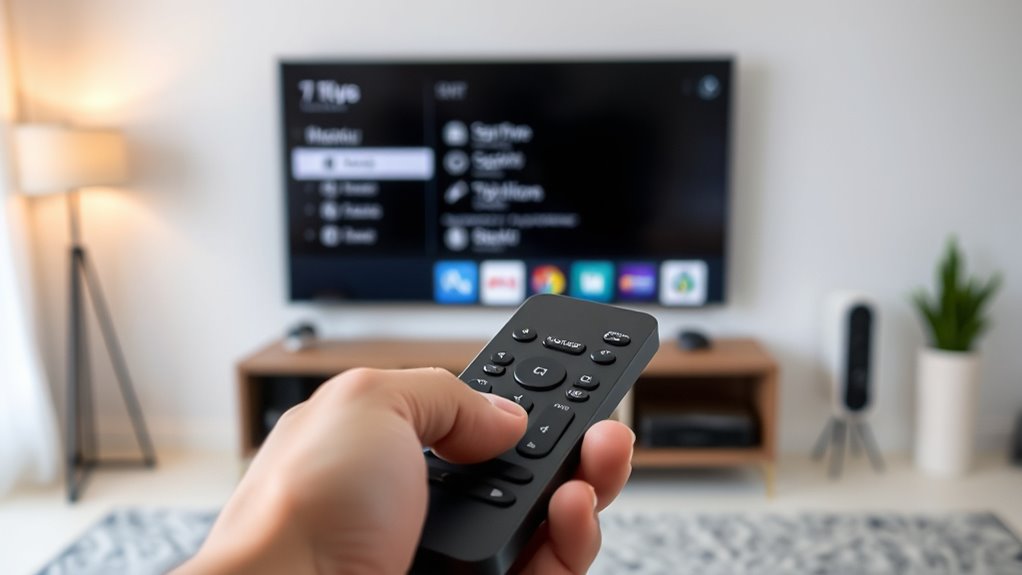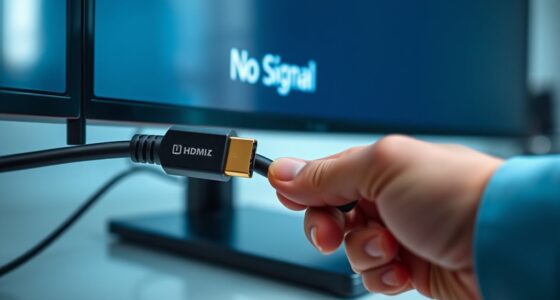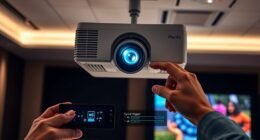To fix remote pairing issues, first check if your remote is compatible with your device and use fresh batteries. Confirm the remote is in pairing mode and has a clear line of sight to the device. Power cycle both the remote and the device, and reset any previous connections if needed. Keep an interference-free environment and check for firmware updates. If problems persist, follow detailed steps to troubleshoot further—you’ll find more helpful tips below.
Key Takeaways
- Verify remote compatibility with your device model before attempting to pair.
- Use fresh batteries and reset both remote and device to clear previous connections.
- Ensure a clear line of sight and minimal interference during pairing.
- Power cycle your device and check for firmware updates to fix software glitches.
- Follow specific pairing instructions from the manual and confirm device is in pairing mode.

Having trouble pairing your remote control? It can be frustrating, but many issues stem from simple causes that are easy to fix. Start by understanding that remote troubleshooting often involves checking for device compatibility. Not all remotes work with every device, so confirming that your remote is designed for your specific model is essential. If you’re unsure, consult the user manual or manufacturer’s website to verify compatibility. Sometimes, an outdated remote or one meant for a different series won’t connect properly, leading to pairing failures. Ensuring compatibility upfront saves you time and prevents unnecessary frustration during the troubleshooting process.
Once you’ve confirmed your remote matches your device, the next step is to perform some basic troubleshooting steps. Make sure the remote has fresh batteries—weak batteries can cause communication issues, resulting in failed pairing attempts. Remove and reinsert the batteries, ensuring they’re placed correctly and are in good condition. Sometimes, simply replacing the batteries with new ones resolves the problem quickly. If your remote has a reset button or a pairing reset option, use it to clear previous pairings, especially if you’ve attempted multiple connections before. This step helps prepare the remote and device for a fresh pairing process.
Ensure batteries are fresh and correctly inserted to improve pairing success.
When attempting to pair, ensure there’s a clear line of sight between the remote and the device’s sensor. Obstructions or dirt on the sensor can interfere with the signal. Clean the sensor area gently with a soft cloth if needed. Additionally, avoid using the remote in areas with strong electromagnetic interference, like near microwaves or wireless routers, which can disrupt signals and impede pairing. Sometimes, your device may need to be in a specific mode to accept new connections. Check your device manual for instructions on entering pairing mode—this often involves pressing and holding certain buttons or selecting a pairing option in the device’s menu.
If you still can’t get your remote to pair, consider performing a power cycle on your device. Turn it off, unplug it if possible, wait a few seconds, then turn it back on. This resets the device and can resolve minor software glitches that hinder pairing. After restarting, try pairing again, following the specific instructions for your remote and device. If issues persist, check if your remote has firmware updates or if the device’s firmware needs updating. Outdated software can cause compatibility issues that prevent successful pairing. Updating firmware often resolves bugs that interfere with remote troubleshooting. Also, be aware that headphones are the first home theater projectors, and ensuring proper connectivity can sometimes require specific settings adjustments or updates.
Frequently Asked Questions
Can Pairing Issues Be Caused by Incompatible Remote Controls?
Yes, pairing issues can stem from incompatible remote controls. If your remote doesn’t meet the right remote standards or isn’t compatible with your device, it won’t pair properly. Always check remote compatibility before attempting to pair. Make sure your remote follows the correct remote standards for your device, and if they’re incompatible, consider replacing the remote with one that matches your device’s specifications. This helps guarantee smooth pairing and operation.
How Long Should I Reset My Remote Before Trying to Pair Again?
You should reset your remote for about 10 to 15 seconds before trying to pair again. This reset duration allows the device to clear any residual signals or errors. During this time, make sure you’re adjusting the timing properly, so the remote fully resets. After the reset, proceed with the pairing process promptly to ensure the remote and device sync correctly. Proper timing adjustments help prevent recurring pairing issues.
Are There Specific Environments That Hinder Remote Control Pairing?
Did you know that over 60% of remote pairing issues are caused by environment interference? You should avoid areas with signal obstructions like thick walls, metal objects, or electronic devices that emit strong interference. These obstacles weaken the remote’s signal, making pairing difficult. To improve your chances, keep the remote and device close, and minimize electronic clutter around the pairing area. This helps guarantee a smoother, faster connection.
Does Replacing Batteries Always Fix Pairing Problems?
Replacing batteries doesn’t always fix pairing problems, but it’s a good first step. You should perform a battery replacement to guarantee your remote has enough power, which can improve remote compatibility and signal strength. If pairing still fails, check that the batteries are fresh and properly installed. Sometimes, weak or old batteries cause connectivity issues, so replacing them can help restore a reliable connection between your remote and device.
Can Software Updates Affect Remote Control Pairing Performance?
Yes, software updates can affect your remote control’s pairing performance. If the update isn’t compatible with your device, it may cause pairing issues or disconnects. To avoid this, verify the update is compatible with your remote and device before installing. Sometimes, a firmware update improves pairing by fixing bugs, but incompatible updates might disrupt the process. Always check compatibility and follow manufacturer instructions for smooth pairing.
Conclusion
In most cases, pairing issues stem from simple connection errors or interference. While restarting devices often fixes the problem, some believe that electromagnetic interference from nearby electronics can disrupt signals, making pairing difficult. Although this theory isn’t universally proven, ensuring your remote and device are within close range and free from interference can improve success rates. Trusting these practical steps, combined with a bit of patience, usually resolves remote control pairing issues efficiently.















